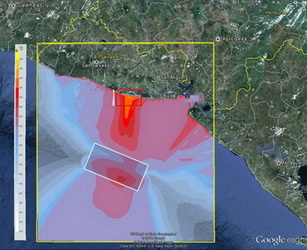Not an official forecast
El Salvador Tsunami, August 27, 2012
Local Impacts
El Salvador Event Page | Local Impacts
NCTR participated in a short post-tsunami survey (organized jointly by NOAA, IOC, Academia and El Salvador government) to investigate reports of local tsunami inundation and impact during this event. The survey data will be used to further test forecast models. This page illustrates preliminary findings that will be documented in the upcoming report and publication.
Regional post-event survey photographs and modeled amplitudes are shown below. Click images to see larger version.
 |
|
|
| This is a Google Earth image of a model run just after the event as a test of the forecast method results for local impact. The MOST inundation model was run with the forecast source, using higher resolution grids developed during ComMIT training*. Maximum computed amplitude plot shows the main focus in the "Bahia de Jiquilisco" region, with a secondary focus just to the south-east in Nicaragua.. (download KMZ file) | This image of the middle section of the Peninsula of San Juan del Gozo (El Salvador) shows intrusion of tsunami sea-water inland, evident from the dying vegetation. The surf line can be easily identified closer to the shore. | |
| This image shows a berm that ran along the coast of most of the San Juan del Gozo peninsula and prevented the wave from penetration too far inland. The berm was also responsible for runup height being generally lower than maximum tsunami heights. | The disposition of the vegetation in this picture indicates the direction and extent of tsunami inundation. The presence of this construction in the tsunami inundation area indicates that this is in fact an area where no tidal or surf inundation takes place confirming the tsunami origin of the runup. |
* The model results for Galapagos, Ecuador tide gauges and El Salvador local inundation are computed based on unverified grids interpolated from ETOPO1 bathymetry and SRTM90 topography, which are known to have large errors in nearshore water depths and topography with dense vegetation. Therefore, these model results should be considered as preliminary and qualitative analyses of the August 27, 2012 El Salvador tsunami.
Disclaimer: The forecasts on these pages show the results of ongoing research to enhance tsunami science and to improve NOAA operational tsunami forecasts. These products were developed during or shortly after the tsunami event, are intended for research use, and are not an official forecast. They should not be used as the basis of any public or private policy decisions. Please contact NCTR to find if there are more detailed follow-on analysis results.
